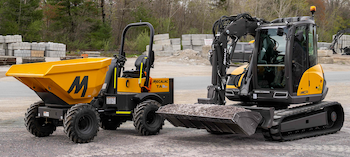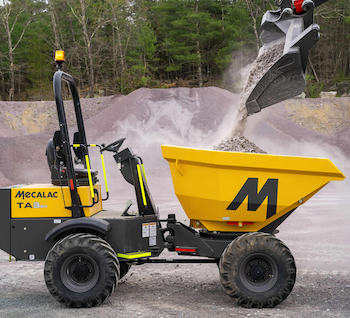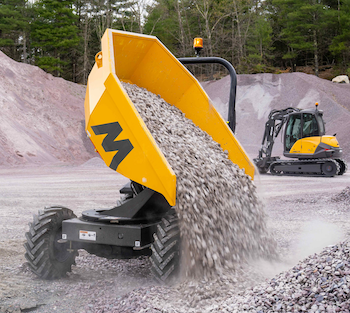The scoop on site dumpers
North American contractors are taking notice of site dumpers that are already very popular in Europe.
by Peter Bigwood
 |
|
Contractors looking for compact equipment solutions that offer more for their investment are starting to take notice of site dumpers paired with compact excavators. |
 |
|
Site dumpers drive productivity because the skip has a capacity double that of the common skid steer bucket. |
 |
| Unlike skid steers, site dumpers swivel and tip material out of the bucket without the need to reposition the entire machine. |
If you visit a construction job site in Europe, chances are you will see a site dumper. In fact, over the course of the project, you might see a whole fleet of site dumpers. The crew will probably start by using a 9-ton model as they clear the site, transition to a 6-ton unit when they’re moving material, then go down to the 3-ton model as the buildings start going up. Lastly, they’ll break out a one-ton site dumper to put the finishing touches on landscaping.
You’re less likely to see a site dumper in North America, much less an entire fleet. However, contractors looking for compact equipment solutions that offer more for their investment are starting to take notice of the factors that make the equipment so popular overseas. With advanced safety features and a compact footprint, site dumpers offer outstanding efficiency and safety on all job sites, especially those where space is at a premium.
Current site dumper market in North America
While contractors in Europe, accustomed to compact jobsites, have long appreciated the benefits of the site dumper in industries ranging from construction to agriculture, aggregate, landscape and more, North America’s wide-open spaces invited and allowed larger equipment. Now, as urban sprawl continues and job sites become smaller with heightened safety concerns, contractors across multiple industries are reconsidering the site dumper.
Many concrete contractors already embrace site dumpers. With numerous concrete jobs requiring the delivery of concrete in tight areas that simply won’t accommodate a large mixer truck or pump truck, site dumpers paired with an optional chute accessory offer a viable and efficient solution. The optional chute attachment provides an added benefit of precisely dumping the concrete without splashing, effectively minimizing the cleanup that is often required with larger trucks.
The popularity of the site dumper in North America extends beyond the concrete industry into landscaping applications as well. Originally gaining traction in hardscaping applications, site dumpers now operate on golf courses and cemeteries. The interest in these segments rests on the benefits of high flotation, low-impact tires, which limit disruption to the turf or ground as work is completed. This protects the manicured surfaces of golf courses and cemeteries and minimizes the time and cost associated with the repair of torn-up turf.
Growing popularity this side of the pond
While the benefits of site dumpers shine in key applications, growing market challenges are casting a spotlight on the efficiency and safety benefits site dumpers offer. With the increasing popularity of mini excavators and skyrocketing demands for infrastructure, site dumpers offer the ideal complement to a growing number of job sites for a variety of reasons.
Perhaps at the heart of expanding acceptance is the enhanced efficiency site dumpers offer over traditional equipment solutions. Though skid steers were once the standard on any job site for moving a variety of materials, contractors are finding that replacing a skid steer with a skip (site dumper) and mini excavator duo often results in three to four times the material handling capacity. That’s because they can load material directly into the skip — or bucket — and maneuver wherever needed, rotate the skip and then tip it out.
With a skid steer, contractors end up making more trips hauling material back and forth, often just clearing it out of the way and re-loading it again later to haul to a final destination. With a site dumper, operations leave the material in the skip until it is completely full, then easily haul and tip it out.
Additionally, site dumpers drive productivity because the skip has a capacity double that of the common skid steer bucket. Some manufacturers offer 3-ton models with a capacity of up to 1.3 cubic yards for liquid material such as concrete, 1.7 cubic yards for struck material such as aggregate and 2.5 cubic yards for heaped material like mulch.
A more compact design and tighter operating footprint further enhances efficiency. The forward and swivel tipping mechanisms of site dumpers allow contractors to maintain a small job site footprint and improve safety. Unlike skid steers, site dumpers swivel and tip material out of the bucket without the need to reposition the entire machine. This allows operation in tighter spaces and minimizes additional maneuvering around an already tight jobsite, further benefitting site safety.
Considerations for site dumper selection
To realize the numerous benefits of the site dumper, it is paramount that contractors not just choose any brand or model, but a high quality one from a trusted manufacturer.
While site dumpers may seem like rather simple and straightforward equipment solutions, don’t be fooled into thinking the only difference between them is the paint and the price. Many features, though subtle to the eye, greatly affect things like safety, ease of operation and performance. It’s important to pay attention to some key details.
As sites get smaller and pressures increase to get more done, a keen focus on safety protects not only the operator but the entire job site and the company as a whole.
Site dumpers designed with precise attention to detail ensuring perfectly symmetrical wheels equal distance from the center post of the machine maximize safety and stability even while driving through heavily rutted areas in mud or other unstable terrain. This reduces or eliminates the risk of tipping and provides a smooth ride. Additionally, some manufacturers offer designs with articulated steering, ensuring that back wheels follow the same path as the front, further enhancing safety and stability.
With current labor shortages, especially a lack of skilled or experienced labor, ease of use and intuitive controls are another key consideration. Contractors gravitate toward models with controls that are easy to learn and use, benefiting safety and allowing for a lower barrier to entry for operators at any experience level.
Finally, some manufacturers produce site dumpers with engines rated under 75 horsepower. This helps avoid diesel exhaust fluid (DEF) and diesel particulate filter (DPF)-related maintenance.
As the array of site dumper benefits — including capacity, efficiency, safety and reduced diesel maintenance — become more apparent in North America, the growth of the site dumper market will undoubtedly increase.
###
Peter Bigwood is general manager of Mecalac North America.








